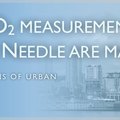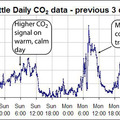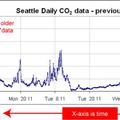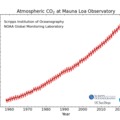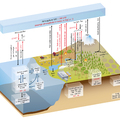Introduction
In 2021, the global average carbon dioxide (CO2) concentration in Earth’s atmosphere was about 0.0415% by volume, or 415 parts per million (ppm). Despite its relatively small overall atmospheric concentration, CO2 is an important component of Earth’s atmosphere because it absorbs and emits infrared radiation resulting in a phenomenon known as the Green House Effect. Cities are local hotspots for emissions resulting from human activities. Working together with the Pacific Science Center and Seattle’s Space Needle, NOAA’s Pacific Marine Environmental Laboratory has installed a carbon dioxide sensor on the top of the Space Needle to examine the variability in atmospheric CO2 over Seattle.
Atmospheric CO2 record at the Seattle Space Needle (click+drag to zoom; click legend to hide/show series):
The plot above shows atmospheric CO2 concentration at local time (PST) measured at two locations on the Seattle Space Needle: 132 m above sea level (92 m above ground level) and 227 m above sea level (186 m above ground level). At the bottom of the plot, you can toggle on or off additional atmospheric CO2 records from regional buoys, including Twanoh and Dabob in the Hood Canal and La Push and Cape Elizabeth on the outer Washington coast. The atmospheric record at the WHOTS buoy in the central Pacific Ocean is also provided as an example of an atmospheric record in the open ocean away from the North American continent.
To find more information about how to read and interpret the plots, click on the links on the left hand side of the page. Access the CO2 record collected on the Seattle Space Needle here.
For access to additional atmospheric CO2 records, see the Global Greenhouse Gas Reference Network of NOAA's Global Monitoring Laboratory.

